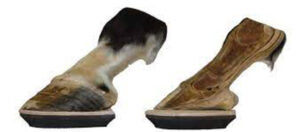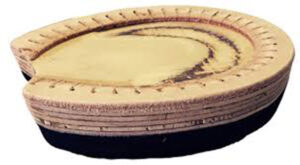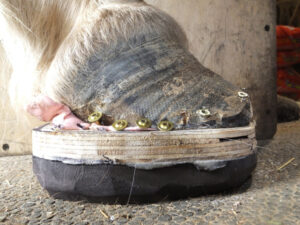Clogs for Equine Laminitis
Laminitis often results in a great deal of damage to the soft tissue structures of the foot, notably the lamellae and the vascular system. The blood flow becomes compromised, leading to a loss of nutrition to the foot; damaged tissues require more nutrients, not fewer.
Veins in the foot are extremely muscular, and during laminitis there are varying degrees of venospasm, or contracted like a muscle spasm, preventing blood from getting through the vessels, leading to stagnation of blood within the foot. Laminits causes bleeding, tissue tearing, swelling, and increased pressure within the hoof capsule. Blood is limited to the dorsal hoof wall first, in most cases, causing rotation of the coffin bone within the hoof capsule, which crushes the soft tissues below. Severe pain ensues.
In horses with chronic laminitis, there are three goals for therapy: to stabilize the distal phalanx within the hoof capsule, to control pain, and to encourage new hoof growth to assume the most normal relationship to the distal phalanx possible. Realignment of the third phalanx to create a better relationship of the solar surface of the distal phalanx with the ground is used as the basis for treating chronic laminitis.
The horse clog consists of plywood, deck screws, EVA (ethylene vinyl acetate) plastic, and casting tape to help anchor the shoe to the wall. The plywood is glued to the rubber and the front and back of the shoe are often beveled, allowing the horse to shift its weight to nearly any angle when standing on soft ground. Deck screws are used around the hoof, into the wood to hold the shoe in place. Casting tape is used to further attach the shoe to the hoof. Some clogs have been made purely from wood, with a small base and beveled/rolled wood at the toe and heels. The wood can be carved out where the tip of the coffin bone lies, to reduce pressure on the bone. The horse can stabilize its hoof angle in one spot better than a regular metal shoe, redistributing the load on internal structures of the foot. This may help spastic blood vessels to relax and dilate, encouraging increased blood flow within the foot. The wood of the shoe absorbs more shock than a metal shoe, as the hoof lands on the ground. The shoe should not wedge the heel up, forcing the tip of the third phalanx to point into the ground. This is extremely painful. Every attempt should be made to realign the foot as closely to normal as possible.
It has been estimated that sole growth doubles, in many cases, within 30 days of clog application, due to the increased circulation to the foot via less venospasm. This can be seen radiographically during each shoeing.
Circulation within the hoof can be visualized by injecting contrast material into the veins of the pastern, kept localized using a tourniquet, and a radiograph is taken. This is called a venogram.
If the circulation within the hoof becomes compromised, permanent damage can result to the tissue due to lack of nutrients. This sets up a vicious cycle of continuing damage from low blood flow; the less blood to the tissues, the more damage occurs, further hampering blood flow to the tissues. When the blood supply to the dorsal hoof wall decreases, the tissues die and the coffin bone rotates away from the hoof wall, damaging the vascular supply beneath. Sole growth then decreases from lack of blood flow and the thin sole cannot absorb much concussive force.
Damaged hoof structures need to be supported and protected. Laminitis destroys the integrity and strength of the laminae, tearing the hoof apart. There are two major forces pulling the coffin bone away from the hoof wall- the weight of the horse and the ground force during ambulation. The horse’s weight is held by the deep digital flexor tendon (DDFT), which attaches to the bottom of the third phalanx and flexes the limb. These forces are reduced when breakover is moved toward the heels with the rolled toe of the clog.
The shoeing process starts with the veterinarian and farrier watching the horse walk, conducting a physical examination, and taking radiographs to visualize the positions and conditions of the inner foot structures. Then the foot is trimmed carefully and correctly, any abscesses are cleaned out and packed, and the excess toe wall common to chronically laminitic cases is rasped off to realign the wall with the coffin bone. A hoof with more normal-appearing conformation will grow and function more normally.
Resets are done every four to six weeks on most horses. Anti-inflammatory medications to control pain, inflammation, and swelling are also used to facilitate healing.
The clog results in immediate pain relief as it increases blood and lymphatic flow and improves ambulation and weight distribution. The horse relaxes, has a more normal stance, and has increased voluntary movement, although movement shoe be restricted until some healing has occurred; too much movement may further compromise the tissues and worsen the lameness. Horses in severe pain may still be in considerable pain even when the clogs are in place. If the pain cannot be controlled via medication and shoeing, surgery to decrease the pull of the DDFT or euthanasia should be considered.
An alternative to the clog is the Glushu, a lightweight aluminum shoe, over molded with a flexible cuff, which provides a completely nail free horse shoeing solution. Glushu is a non invasive, lightweight, shoe inside a cushion which provides shock absorption and eliminates stress or damage to the horse’s hoof. This shoe can help horses that have not done as well in a clog as expected. The cuff can be glued to the foot or removed in the front to fit the laminitic toe, provide better break over, and allow the shoe to be moved caudally to provide heel support.













